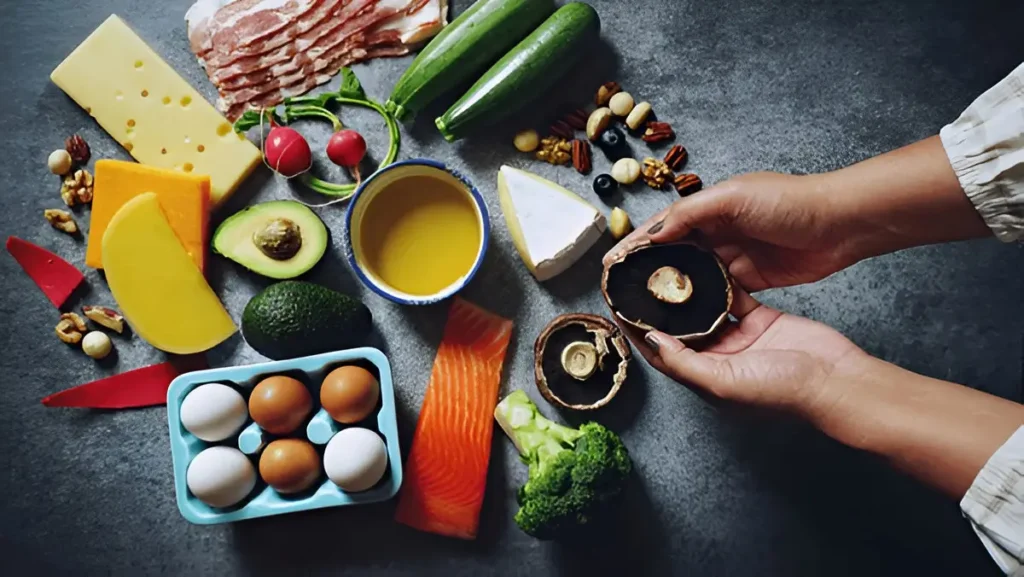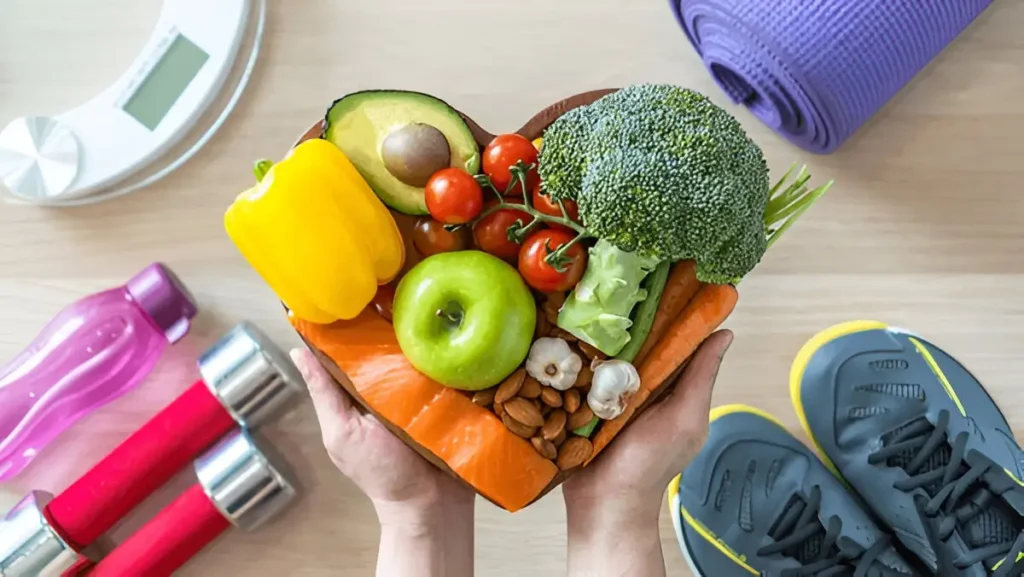You’re considering a significant change in your eating habits, and the ketogenic diet has caught your attention. This low-carb, high-fat diet has gained popularity for its potential to promote weight loss and improve overall health.
The keto diet involves a metabolic shift, where your body burns fat for energy instead of carbohydrates. By drastically reducing your carb intake, you can induce a metabolic state called ketosis, in which your body becomes efficient at burning fat.
Key Takeaways
- Understand the fundamental principles of the ketogenic diet and its benefits.
- Learn how to implement a low-carb lifestyle effectively.
- Discover the potential advantages of adopting a keto diet.
- Explore the different types of ketogenic diets and their applications.
- Gain insights into managing your diet for optimal results.
What Is The Keto Diet? Science And Basic Principles

As you embark on your keto journey, it’s essential to grasp the fundamental science behind the diet, including the process of ketosis and fat adaptation. The keto diet, or ketogenic diet, is a dietary approach that has gained popularity for its potential in promoting weight loss and improving overall health.
The Science Behind Ketosis And Fat Adaptation
The keto diet works by putting your body into a state of ketosis, a metabolic state in which your body burns fat for fuel instead of carbohydrates. Normally, your body relies on glucose, a type of sugar derived from carbohydrates, as its primary energy source. However, when carbohydrate intake is drastically reduced, your liver begins to break down fat into molecules called ketones, which then become the primary energy source for your body and brain. This process is known as fat adaptation.
Key aspects of ketosis include:
- Reduced insulin levels, allowing for increased fat breakdown
- Increased production of ketones by the liver
- Shift in the body’s primary energy source from glucose to ketones
The History And Evolution Of The Ketogenic Diet
The ketogenic diet has its roots in the early 20th century when it was first used as a therapeutic approach for managing epilepsy. Over the years, the diet has evolved, with various versions being developed for different health goals, including weight loss and improved metabolic health. Initially used primarily in clinical settings, the keto diet has transitioned into mainstream dietary practice, with a growing body of research supporting its potential benefits.
| Year | Development |
|---|---|
| 1920s | First used as a treatment for epilepsy |
| 1990s | Resurgence in popularity for weight loss |
| 2010s | Mainstream acceptance and widespread adoption |
Different Types Of Ketogenic Approaches
There are several variations of the ketogenic diet, each with its own specific guidelines and applications. The most common types include:
- Standard Ketogenic Diet (SKD): A very low-carb, moderate-protein, and high-fat diet.
- Cyclical Ketogenic Diet (CKD): Involves periods of higher carbohydrate intake, such as during intense workout days or for specific dietary needs.
- Targeted Ketogenic Diet (TKD): Allows for additional carbohydrate intake around workout times to support performance.
- High-Protein Ketogenic Diet: Similar to SKD but with a higher protein intake, which can be beneficial for those looking to maintain muscle mass.
Understanding these different approaches can help you tailor the keto diet to your specific needs and goals, whether you’re focusing on weight loss, improved energy, or enhanced mental clarity.
How To Start Your Keto Journey: A Step-By-Step Guide

The key to a successful keto lifestyle lies in the preparation, from calculating your macronutrient needs to planning your meals. As you embark on this journey, understanding the foundational steps will make a significant difference in your progress and overall success.
Step 1: Calculate Your Macronutrient Needs
To start your keto diet, you first need to determine your daily macronutrient requirements. This involves calculating your ideal intake of fats, proteins, and carbohydrates. A typical keto diet consists of 70-80% fats, 15-20% proteins, and 5-10% carbohydrates. You can use an online keto calculator to simplify this process.
For instance, if your daily caloric intake is 2,000 calories, your keto diet breakdown would be:
| Macronutrient | Percentage | Calories | Grams |
|---|---|---|---|
| Fats | 75% | 1500 | 167 |
| Proteins | 20% | 400 | 100 |
| Carbohydrates | 5% | 100 | 25 |
Step 2: Clean Out Your Pantry And Restock
Once you’ve determined your macronutrient needs, it’s time to prepare your kitchen. Begin by cleaning out your pantry of high-carb foods, such as sugary snacks, grains, and starchy vegetables. Replace these with keto-friendly foods like meats, fish, eggs, full-fat dairy, oils, and low-carb vegetables.
Restocking your pantry with the right foods will make it easier to stick to your keto meal plan. Some essentials include:
- Avocados
- Nuts and seeds
- Olive oil and coconut oil
- Fatty fish like salmon
- Low-carb vegetables like spinach and broccoli
Step 3: Plan Your First Week Of Meals
Planning your meals in advance is crucial for a successful keto diet. Start by creating a 7-day keto meal plan that includes breakfast, lunch, dinner, and snacks. You can find numerous keto-friendly recipes online to inspire your meal planning.
For example, your meal plan might include:
- Breakfast: Scrambled eggs with spinach and avocado
- Lunch: Grilled salmon with a side of cauliflower rice
- Dinner: Beef stir-fry with vegetables cooked in coconut oil
- Snacks: Celery sticks with almond butter or a handful of macadamia nuts
By following these steps, you’ll be well on your way to adopting a successful keto lifestyle. Remember, the key is to stay consistent and be patient with your progress.
Keto-Friendly Foods: Complete Eating Guide

Navigating the world of keto-friendly foods can seem daunting at first, but with the right guidance, you’ll be on your way to a healthier you. The key to a successful keto diet lies in understanding which foods to embrace and which to avoid. By focusing on whole, nutrient-dense foods, you’ll not only achieve your dietary goals but also enhance your overall well-being.
Foods To Embrace On Keto
When following a keto diet, it’s crucial to focus on foods that are high in fat, moderate in protein, and low in carbohydrates. This balance is what puts your body into a state of ketosis, where it burns fat for energy instead of carbs.
Healthy Fats And Oils
Healthy fats are the cornerstone of the keto diet. You’ll want to include sources like avocado, olive oil, and fatty fish in your meals. These foods not only provide the necessary fats but are also rich in nutrients.
- Avocado
- Olive oil
- Fatty fish (salmon, mackerel)
- Nuts and seeds (almonds, chia seeds)
Quality Protein Sources
Moderate protein intake is essential on a keto diet. Focus on quality sources like grass-fed beef, poultry, fish, and eggs. These foods provide the necessary building blocks for muscle repair and growth.
- Grass-fed beef
- Poultry
- Fish
- Eggs
Low-Carb Vegetables And Fruits
While vegetables and fruits are naturally higher in carbs, there are many low-carb options that can be enjoyed in moderation. Leafy greens, broccoli, and citrus fruits are great choices.
- Leafy greens (spinach, kale)
- Broccoli
- Citrus fruits (oranges, lemons)
- Avocados (yes, they’re a fruit!)
Foods To Eliminate From Your Diet
Just as important as knowing what to eat is understanding what to avoid. Foods high in sugar, grains, and unhealthy fats can derail your keto progress.
Sugary foods and drinks are obvious culprits, but you should also limit or avoid grains like wheat, rice, and pasta, as well as legumes and starchy vegetables.
Decoding Food Labels For Hidden Carbs
One of the challenges of maintaining a keto diet is navigating food labels. Many products contain hidden carbs in the form of added sugars, preservatives, and other ingredients. Always read labels carefully, and be aware of serving sizes.
When checking labels, look for the total carbohydrate content and be mindful of ingredients like maltodextrin, dextrose, and other sugar derivatives that can kick you out of ketosis.
Creating Your Weekly Keto Meal Plan

A well-structured keto meal plan is the backbone of your ketogenic journey, ensuring you stay on track and achieve your health goals. By planning your meals, you can avoid last-minute decisions that might derail your diet. In this section, we’ll guide you through creating a sample 7-day keto meal plan, discuss the benefits of batch cooking and meal prep, and provide tips on maintaining your keto lifestyle when eating out or attending social gatherings.
Sample 7-Day Keto Meal Plan For Beginners
Starting a keto diet can be daunting, but a well-planned meal plan can simplify the process. Here’s a sample 7-day keto meal plan designed for beginners:
- Monday: Breakfast – Scrambled eggs with spinach and avocado; Lunch – Grilled salmon with a side salad; Dinner – Beef stir-fry with vegetables cooked in coconut oil.
- Tuesday: Breakfast – Keto coffee with coconut oil; Lunch – Chicken Caesar salad; Dinner – Pork chops with roasted broccoli.
- Wednesday: Breakfast – Spinach and feta omelette; Lunch – Turkey lettuce wraps; Dinner – Grilled steak with a side of cauliflower mash.
- Thursday: Breakfast – Avocado smoothie with almond milk; Lunch – Chicken breast with a side of mixed greens; Dinner – Baked chicken thighs with zucchini noodles.
- Friday: Breakfast – Keto pancakes made with almond flour; Lunch – Tuna salad with celery sticks; Dinner – Grilled lamb chops with roasted asparagus.
- Saturday: Breakfast – Breakfast burrito with scrambled eggs and avocado wrapped in a low-carb tortilla; Lunch – Grilled chicken breast with a side salad; Dinner – Beef burgers topped with cheese and bacon, served with a side of sautéed spinach.
- Sunday: Breakfast – Smoked salmon with cream cheese on a low-carb bagel; Lunch – Chicken soup with vegetables; Dinner – Pork tenderloin with roasted Brussels sprouts.
This meal plan provides a variety of keto-friendly foods and ensures you’re getting the right balance of macronutrients. Feel free to swap out ingredients based on your personal preferences and dietary needs.
Batch Cooking And Meal Prep Strategies
Batch cooking and meal prep are essential strategies for maintaining a keto diet. By preparing your meals in advance, you can save time during the week and ensure you’re always eating keto-friendly foods. Here are some tips:
- Cook proteins like chicken, beef, and pork in bulk.
- Roast a large batch of vegetables at once.
- Prepare keto-friendly snacks like cheese sticks, hard-boiled eggs, and nuts.
- Use a slow cooker to prepare meals that simmer all day.
By adopting these strategies, you can simplify your keto journey and stay on track even on busy days.
How To Navigate Restaurants And Social Gatherings
Maintaining a keto lifestyle doesn’t mean you have to avoid social gatherings or eating out. Here are some tips for navigating these situations:
- Research the restaurant’s menu beforehand to identify keto-friendly options.
- Choose dishes that are centered around protein and vegetables.
- Don’t be afraid to ask for modifications, such as substituting high-carb sides for vegetables.
- Be mindful of hidden carbs in sauces and dressings.
By being prepared and making informed choices, you can enjoy social gatherings and dining out while staying true to your keto lifestyle.
The Health Benefits Of A Ketogenic Lifestyle
As you embark on a ketogenic journey, you may experience a multitude of benefits that can significantly improve your overall well-being. The ketogenic diet, characterized by its low-carb and high-fat regimen, has been associated with various health advantages, ranging from weight management to enhanced mental clarity.
Weight Management And Metabolic Advantages
One of the most notable benefits of the keto diet is its effectiveness in weight management. By inducing a state of ketosis, the body becomes highly efficient at burning fat for energy, leading to significant weight loss. Additionally, the keto diet can help regulate metabolic processes, improving insulin sensitivity and reducing the risk of metabolic syndrome.
- Enhanced fat burning capabilities
- Improved insulin sensitivity
- Reduced risk of metabolic syndrome
Enhanced Energy Levels And Mental Performance
Many individuals on the keto diet report increased energy levels and improved mental clarity. The high-fat diet supports brain health, potentially reducing the risk of neurodegenerative diseases. Furthermore, the stable energy supply from fat metabolism can lead to enhanced physical performance and endurance.
- Stable energy supply
- Improved mental clarity and focus
- Potential reduction in neurodegenerative disease risk
Therapeutic Applications For Specific Conditions
The ketogenic diet has been explored for its therapeutic potential in managing various health conditions, including epilepsy, type 2 diabetes, and certain mental health disorders. The diet’s ability to alter metabolic pathways and reduce inflammation may offer benefits for individuals with these conditions.
Some of the therapeutic applications include:
- Epilepsy management
- Type 2 diabetes management
- Potential benefits for mental health disorders
Overcoming Keto Side Effects And Challenges
While the keto diet offers numerous benefits, it’s not entirely smooth sailing; some individuals may experience side effects. Understanding these challenges and knowing how to address them can make a significant difference in your keto journey.
Conquering The Keto Flu: Symptoms And Solutions
The keto flu, also known as the “ketogenic flu,” refers to a set of symptoms that some people experience when transitioning to a ketogenic diet. Common symptoms include fatigue, headache, brain fog, and nausea. These symptoms are largely due to the body’s adaptation to using ketones as a primary energy source instead of glucose.
To alleviate keto flu symptoms, it’s essential to stay hydrated and consider increasing your salt intake. Drinking plenty of water and replenishing electrolytes can help mitigate these effects. You can also try incorporating electrolyte-rich foods or supplements into your diet.
Maintaining Electrolyte Balance: Sodium, Potassium, Magnesium
Electrolytes play a crucial role in maintaining various bodily functions, including nerve and muscle function, hydration, and pH balance. On a keto diet, it’s easy to become deficient in key electrolytes like sodium, potassium, and magnesium.
- Sodium: Increase your sodium intake through salt or electrolyte-rich broths.
- Potassium: Consume potassium-rich foods like avocados, spinach, and mushrooms.
- Magnesium: Include magnesium-rich foods such as dark leafy greens, nuts, and seeds in your diet.
When To Consult A Healthcare Professional
While many people successfully navigate the keto diet without major issues, some may experience severe or persistent side effects. If you encounter any of the following, it’s advisable to consult a healthcare professional: severe dehydration, persistent keto flu symptoms, or significant changes in blood sugar or blood pressure.
Being aware of your body’s response to the keto diet and taking proactive steps to manage side effects can significantly enhance your overall experience and success on this dietary journey.
Advanced Keto Strategies For Long-Term Success
To achieve long-term success on the keto diet, it’s essential to implement advanced strategies that go beyond the basics. As you continue on your ketogenic journey, you’ll encounter new challenges that require refined techniques and a deeper understanding of your body’s response to the diet.
Effective Tracking Methods And Useful Apps
Monitoring your progress is crucial for making adjustments and ensuring you’re on track to meet your goals. Utilizing the right tools can simplify this process. Popular keto tracking apps include MyFitnessPal, MyMacros+, and Carb Manager, which help you log your food intake, track macros, and monitor ketone levels.
These apps not only assist in maintaining a food diary but also provide insights into your nutrient intake, helping you make informed decisions about your diet. By leveraging technology, you can streamline your keto journey and stay focused on your objectives.
| App Name | Key Features | Platform |
|---|---|---|
| MyFitnessPal | Comprehensive food database, macro tracking, barcode scanner | iOS, Android |
| MyMacros+ | Customizable macro tracking, meal planning, integration with health apps | iOS, Android |
| Carb Manager | Low-carb meal planning, keto recipe database, community support | iOS, Android |
Breaking Through Weight Loss Plateaus
Encountering a weight loss plateau is a common experience for many on the keto diet. To overcome this, consider reassessing your macro ratios or incorporating intermittent fasting to boost your metabolic rate. Additionally, increasing your physical activity or changing your exercise routine can help stimulate further weight loss.
It’s also essential to monitor your hidden carb intake from sources like sauces, condiments, and certain vegetables. Making these adjustments can help you break through the plateau and continue towards your weight loss goals.
Combining Exercise With Your Ketogenic Lifestyle
Incorporating exercise into your keto lifestyle not only enhances weight loss but also improves overall health and well-being. Resistance training is particularly beneficial as it helps maintain muscle mass while losing fat. Additionally, high-intensity interval training (HIIT) can be an effective way to improve cardiovascular health and boost metabolism.
It’s crucial to listen to your body and adjust your exercise routine according to your energy levels, especially during the initial adaptation phase. As you become more fat-adapted, you’ll likely find that your energy levels increase, allowing for more intense and longer workouts.
Common Keto Mistakes And Their Solutions
To achieve success on the keto diet, it’s essential to understand and avoid common errors that can impede your progress. While the ketogenic diet offers numerous benefits, navigating its challenges is crucial for long-term success.
Underconsumption Of Healthy Fats
One of the most significant mistakes on the keto diet is underconsuming healthy fats. The keto diet relies heavily on fat as a primary source of energy. Failing to consume enough can lead to fatigue, hunger, and poor overall performance on the diet. To avoid this, focus on incorporating healthy fats like avocado, olive oil, and fatty fish into your meals.
Additionally, be mindful of your fat intake at each meal to maintain a balanced macronutrient ratio. Using a food diary or an app to track your daily intake can be beneficial.
Carb Creep: Identifying And Eliminating Hidden Carbs
Another common issue is “carb creep,” where individuals unintentionally consume more carbs than they realize. This can happen due to hidden carbs in sauces, condiments, and processed foods. To combat this, always read food labels carefully and be aware of the carb content in foods that are typically considered keto-friendly.
When eating out, ask for nutritional information or choose dishes that are inherently low in carbs. Being vigilant about carb intake is key to maintaining ketosis.
Neglecting Micronutrients And Fiber
Neglecting micronutrients and fiber is another critical mistake. A diet lacking in essential vitamins and minerals can lead to a range of health issues. Ensure you’re consuming a variety of vegetables, nuts, and seeds to meet your micronutrient needs. Additionally, prioritize fiber-rich foods like leafy greens and chia seeds to support digestive health.
Consider consulting with a healthcare professional or a registered dietitian to ensure you’re meeting your nutritional needs on the keto diet.
Conclusion: Making The Keto Diet Work For Your Lifestyle
Embracing a ketogenic lifestyle can be a transformative journey, leading to significant weight loss and improved overall health. As you’ve learned, adopting the keto diet requires a comprehensive understanding of its principles, from calculating your macronutrient needs to navigating social gatherings.
To make the keto diet work for your lifestyle, focus on creating a personalized approach that suits your needs and preferences. This involves being mindful of your food choices, staying hydrated, and listening to your body’s nutritional needs. By doing so, you’ll be better equipped to overcome common challenges and maintain a state of ketosis.
As you continue on your keto journey, remember that consistency and patience are key. With time, you’ll become more attuned to your body’s responses, allowing you to make adjustments and optimize your ketogenic lifestyle for sustainable weight loss and overall well-being.
FAQ
What is the keto diet, and how does it work?
The keto diet, short for ketogenic diet, is a low-carb, high-fat diet that puts your body into a state of ketosis, where it burns fat for energy instead of carbohydrates. By drastically reducing the intake of carbs and increasing fat consumption, your body adapts to using ketones as its primary energy source.
How do I know if I’m in ketosis?
You can determine if you’re in ketosis by using keto strips or a breath analyzer to measure the level of ketones in your urine or breath. Additionally, you may experience certain physical symptoms such as dry mouth, increased thirst, or a metallic taste, although these can vary from person to person.
What are the benefits of a ketogenic lifestyle?
A ketogenic lifestyle can lead to weight loss, improved blood sugar control, increased energy levels, and enhanced mental clarity. It may also have therapeutic benefits for certain medical conditions, such as epilepsy and type 2 diabetes.
Can I follow a keto diet if I have dietary restrictions or preferences, such as vegetarian or vegan?
While a traditional keto diet is often associated with animal products, it is possible to adapt the diet to suit vegetarian or vegan preferences by focusing on plant-based fats and protein sources. However, careful planning is required to ensure you’re meeting your nutritional needs.
How do I avoid common keto mistakes like underconsumption of healthy fats or carb creep?
To avoid underconsumption of healthy fats, make sure to include a variety of fat-rich foods in your diet, such as avocados, olive oil, and fatty fish. To prevent carb creep, be mindful of portion sizes, read food labels carefully, and track your daily carb intake.
What are some effective ways to track my progress on a keto diet?
You can track your progress by monitoring your weight, measuring body fat percentage, and using a food diary or mobile app to log your daily food intake and macronutrient ratios.
Can I exercise while following a keto diet, and are there any special considerations?
Yes, you can exercise while on a keto diet. In fact, incorporating physical activity can enhance the benefits of the diet. However, you may need to adjust your workout routine and nutrition plan to ensure you’re fueling your body adequately.
How do I maintain a keto lifestyle long-term, and what are some strategies for overcoming challenges?
To maintain a keto lifestyle, focus on developing sustainable habits, such as meal planning, batch cooking, and staying hydrated. When faced with challenges, such as weight loss plateaus or social pressures, seek support from online communities, healthcare professionals, or registered dietitians for guidance and motivation.



